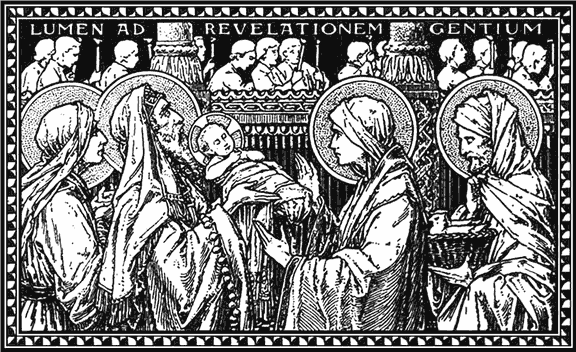We will be celebrating Candlemas for the first time this evening.
The celebration of the Purification of Mary is known to have been celebrated from the times of persecution, for we see its celebration in the Church at Jerusalem in the time of Constantine’s conversion. At first celebrated 40 days after Epiphany, when Epiphany celebrated the Nativity of Our Lord, the Feast settled on February 2 after the Feast of the Nativity was established on December 25. In the Eastern Church it was called Hypapante tou Kyriou, the meeting of the Lord and His mother with Simeon and Anna.
During the Feast today, the priest offers five prescribed orations before he blesses beeswax candles by sprinkling and incensing. The candles are then distributed while the Canticle of Simeon is sung with the antiphon “Lumen ad revelationem gentium et gloriam plebis tuæ Israel,” “A Light to the revelation of the Gentiles, and the glory of thy people Israel,” repeated after every verse. Then follows the procession, and at which all the partakers carry lighted candles in their hands, the choir sings the antiphon “Adorna thalamum tuum, Sion”, composed by St. John of Damascus.
The solemn procession represents the entry of Christ, the Light of the World, into the Temple.
It has been a blessing rediscovering the ancient traditions of the Church. I am grateful every day that the Lord led us home.


13 comments
It’s Imbolc. Halfway between Winter Solstice and Spring Equinox. The Christian celebrations came later. Goddess Bridgid is the bearer of light. We celebrate the return of the light and the hope of the promise of spring. Simple garden tasks are sacred and divine — the wheel of the year, ever turning, ever changing yet constant is life giving. Creative force of the God and Goddess. Birds and the bees, and the flowers and the trees, and this thing called Love.
The Holy Church owns it now.
One day, we’ll probably get Toyotathon and Shark Week too.
Dixi
I was gonna basically say what the above poster said. It’s a pagan celebration that was converted into the Christian church. As are some many other Christian holidays. I think the mental intentions of said beliefs are what matters most but definitely realize the pagan origins of most of your Christian holidays. I’m sure you are likely aware. Torah observant Christian peoples reject non biblical holidays like Christmas etc. To me it’s whatever but it’s worth a thought.
The Holy Church took and baptized and consecrated it all. It is the rock that crushed the empires of the world and “became a great mountain, and filled the whole earth.” We aren’t Judaizers.
Happy Candlemas, indeed! Thanks for sharing the reflection. Where does this excerpt come from?
Thank you. This is the original article: https://fssp.com/candlemas-in-fssp-apostolates/
In our diocese (Orthodox) we celebrate the Presentation of the Lord in the Temple. We chant St. Simeon’s prayer every Vespers. Wonderful that you were able to celebrate the day! I was deathly sick and could not attend the Liturgy.
Candlemas is not in any way associated with paganism. Candlemas, or the Feast of the Purification, is 40 days after the Nativity of Christ (Christmas). Under the Mosaic Law, a woman who gave birth was to present herself to the priests at the Temple for purification. The Virgin Mother, despite not issuing any blood, presented herself out of obedience to the Law on the day prescribed, hence its inclusion as the end of Christmastide.
Many say that the date of the Nativity (and thus the date of the Purification) was chosen in relation to Satunalia or Nativitas Sol Invictus. These claims lack merit. First, the date of Christmas corresponds to the time when Zachary, the husband of Elizabeth, served in the Temple according to St. Luke’s Gospel (which he wrote after speaking to “eye witnesses”, like Mary). Following the cycle mentioned in said Gospel passage, Zachary would have returned to his home after serving at the Temple 9 months prior to June 25…which is 6 months from Dec 25…and the Gospel says that Elizabeth was already 6 months pregnant when Mary conceived through the Holy Ghost (which would thus be Maech 25: the Annunciation). This means that the date of the Nativity was arrived at using, not paganism, but Jewish law and custom.
Further, history shows us that the date of December 25 as the Nativity was celebrated in Rome AT LEAST 200 years before Julian the Apostate established Sol Invictus (to combat against the celebration of the Nativity of the Lord). Jerome argues that Rome celebrated the Nativity on Dec 25 because Rome had the official census documents, and thus would know. It was mentioned in contemporary sources as “an ancient Roman custom”, not celebrated in many places outside of Rome. Any association to pagan practices outside of Rome, then, cannot be considered causal, or even correlational, but merely coincidental.
Amen – thank you.
https://www.history.com/topics/holidays/imbolc
Beautiful post! So happy for you all. Prayers for your family!
Thank you, Alex.
Comments are closed.